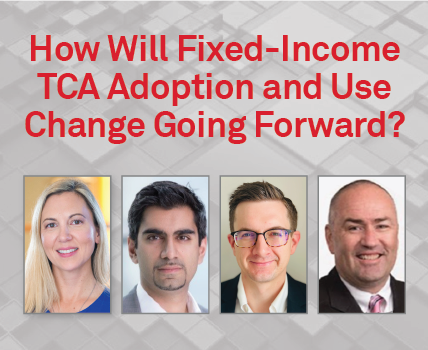Post-Trade Analysis Is Chief Use of Fixed-Income TCA
Although buy-side firms are adopting total cost analysis (TCA) in fixed income to improve trading efficiencies, its use is largely focused on post-trade analysis, with data concerns being the biggest inhibitor, according to the panelists at a recent Coalition Greenwich webinar, “How Will Fixed-Income TCA Adoption and Use Change Going Forward?”
State of TCA Adoption
“At Vanguard, we believe there is a definite need for fixed-income TCA. In the current state, there are plenty of data sources for us to do meaningful research,” says its Head of Fixed Income TCA and Execution Consulting Ross Walter.
However, unlike equities TCA, where a “perfect consolidated tape” is available to do cost and efficiency analytics, the situation is “murky” in fixed income, he admits, prompting many firms to wait “for the data and technology to shake out.” Indeed, while 65% of the 111 buy-side firms participating in a recent Coalition Greenwich study currently use or plan to use fixed-income TCA, many investors remain on the sidelines.
According to Tom Melvin, Director of North American Credit Trading at Invesco, credit traders typically resist adopting new tools, especially one that “potentially questions execution.” But the bigger deterrent for him is data availability, especially during periods of market volatility.
He states, “If you asked a sell-side equity trader how many names he could get a market on for, say, 5,000 shares a nickel wide, on the Russell 2000 Index, it would be 100%. But if you looked at the 1,900 names in the ICE Bank of America U.S. High-Yield Index, maybe you could get a market on a million-up shares on 300 names. How do you evaluate a trader on the 1,600 names that he potentially executed but couldn’t get a market on? That's a question for credit traders, especially in times of volatility, which often leads to illiquidity.”
Bloomberg’s Global Head of Trade Automation & Analytics Ravi Sawhney believes the benefits of TCA adoption extend beyond performance analysis of a firm’s own trading desk, though. “Most clients will try to contextualize their performance versus their peers,” he says.
What to Look for in a TCA solution?
According to the Coalition Greenwich study, the most important use of TCA is as both a pre- and post-trade tool to model trades and analyze trading efficiency. However, for now, firms are mainly using it for post-trade analysis, owing to data constraints. “The post-trade review to judge effectiveness against the benchmark is table-stakes TCA for us. We found that it can be very effective in changing trader habits and informing our trading strategies,” says Ross Walter.
Vanguard uses TCA for U.S. Treasuries and credit trading currently. It has developed its own TCA solution “to have as raw market data as possible.” “That’s easy with equities; in fixed income, we have to weigh the pros and cons of bringing in different data sources,” he says. Still, pre-trade data has increased exponentially as electronification has gathered pace. “The pre-trade analytics will eventually help the post-trade analytics,” contends Tom Melvin.
Ravi Sawhney says different firms want different things from a TCA solution, with some firms opting for only part of its solution.
The Data Challenge
Undoubtedly, getting accurate data is critical for effective TCA as that will determine output quality. At Bloomberg, “integration of the client’s data” into its TCA engine is a “big lift.” For instance, clients are using its post-trade TCA API “to capture data outside of the ecosystem and co-mingle it with other data sets for business intelligence.”
Data availability can also be a challenge for non-electronic trades. At Vanguard, internal data hygiene—such as ensuring all time stamps are accurate—is “table stakes.” Its traders also book voice trades within set minutes of execution.
Can Advanced Tech Help Improve Data Analytics?
Bloomberg has been using AI and ML techniques in its predictive models for a decade. However, Vanguard focuses more on core statistical analysis and hasn’t found “great use” for AL-ML models in terms of “a huge bump-up in predictability or efficiency.”
For Tom Melvin, though, the bigger question for TCA in credit remains how TCA will “encompass market events and risks like, say, the regional bank volatility, in evaluating execution?”

